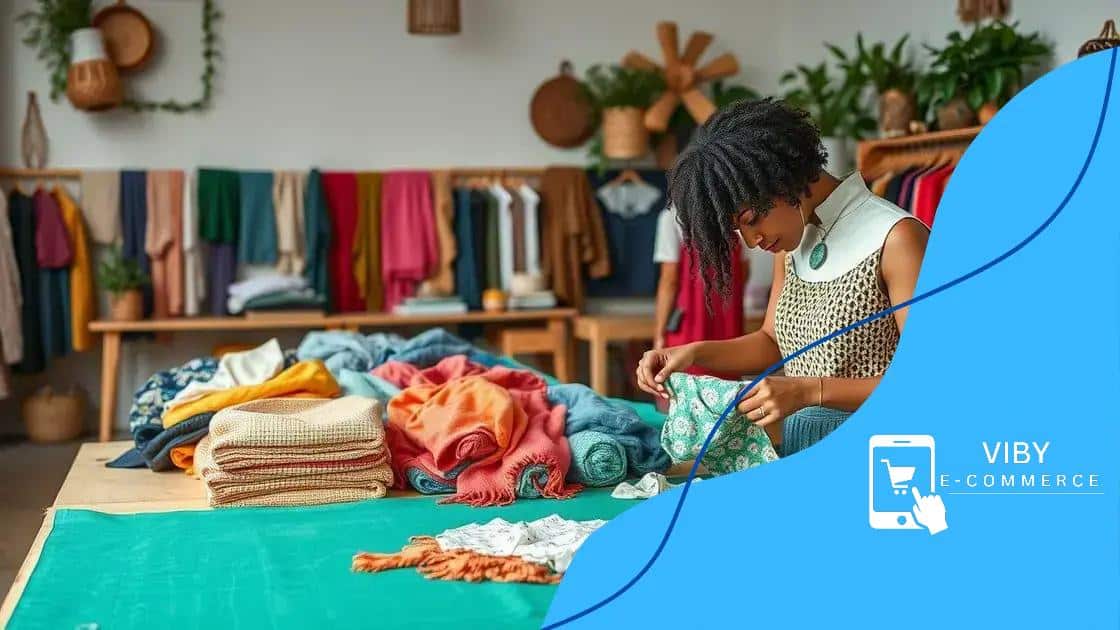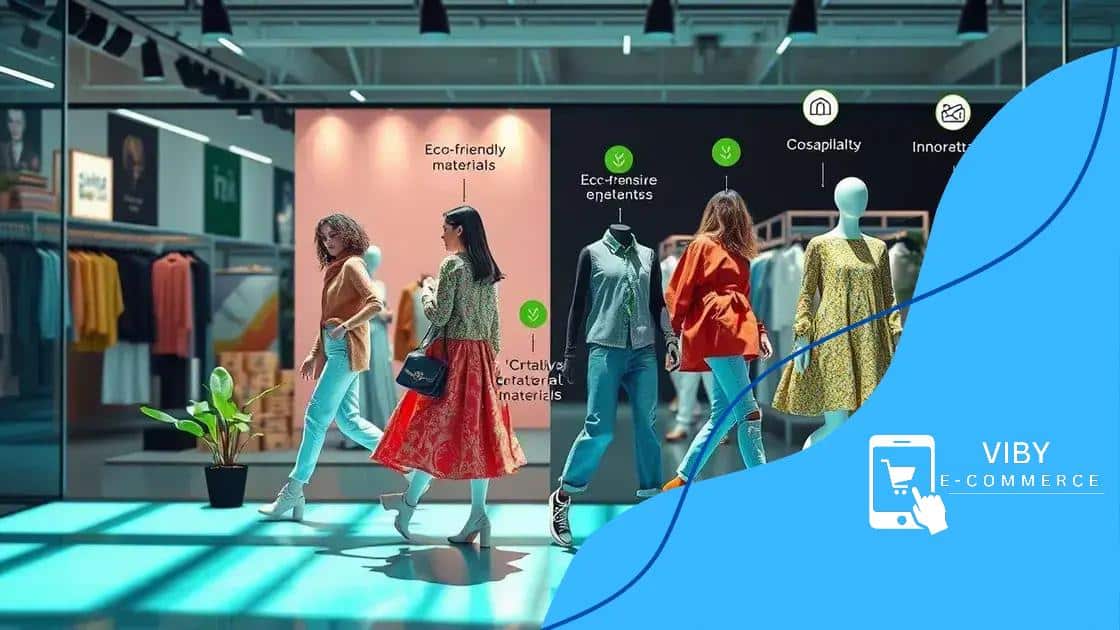How Shein contributes to sustainability efforts with eco-friendly materials

How Shein contributes to sustainability efforts with eco-friendly materials includes using organic cotton, recycled fabrics, and promoting a circular economy while facing challenges in supply chain transparency and consumer engagement.
How Shein contributes to sustainability efforts with eco-friendly materials is a question many fashion enthusiasts are asking today. As the brand pushes boundaries in fast fashion, it sparks curiosity about its commitment to the planet.
An overview of Shein’s sustainability initiatives
An overview of Shein’s sustainability initiatives provides insight into how the brand is stepping up to meet eco-friendly demands. As part of the fashion industry, Shein is aware of its impact and is actively making changes.
To highlight its commitment, Shein has introduced various sustainability initiatives. These efforts include…
Key Sustainability Initiatives
Firstly, Shein is focusing on using recycled materials. This helps reduce waste and utilize existing resources more effectively. The brand is also committed to transparency in its supply chain by sharing information about sourcing and manufacturing practices.
- Use of eco-friendly fabrics
- Partnerships with sustainable suppliers
- Investment in innovative recycling technologies
- Engagement in community sustainability projects
In addition, Shein has developed programs aimed at minimizing environmental impact. These programs help ensure that products are created with a minimal carbon footprint.
Community Engagement
Moreover, the company is working to involve its customers. By promoting sustainable fashion choices, Shein encourages shoppers to consider their consumption habits. This initiative helps create awareness about the importance of eco-friendly practices.
As the brand strives to improve, the initiatives reflect Shein’s aim to be a responsible player in the fashion industry. The journey towards sustainability is ongoing, and every effort counts towards a greener future.
The role of eco-friendly materials in Shein’s collections
The role of eco-friendly materials in Shein’s collections is becoming increasingly important. As sustainability takes center stage, Shein has embraced this shift, making significant changes in its fabric choices.
By focusing on sustainable materials, the brand not only addresses environmental concerns but also meets the growing demand from consumers for more responsible fashion. A variety of eco-friendly materials are now featured in Shein’s collections.
Types of Eco-Friendly Materials
Some of the most common materials include…
- Organic cotton: This material is grown without harmful pesticides, making it safer for the environment.
- Recycled polyester: Made from plastic bottles, it helps reduce waste by reusing existing resources.
- Tencel: A biodegradable fabric produced from sustainable wood sources, Tencel is both soft and environmentally friendly.
- Bamboo fabric: A renewable resource that grows quickly and requires much less water than traditional cotton.
Utilizing such materials allows Shein to create fashionable items while minimizing the environmental footprint. This strategy is not only about looking good but also about doing good for the planet.
Benefits of Using Eco-Friendly Materials
Beyond aesthetics, there are numerous benefits to using eco-friendly materials. For one, these fabrics often result in lower water consumption during production. They also help reduce greenhouse gas emissions. As consumers become more environmentally conscious, brands like Shein need to adapt to emerging trends.
Incorporating these materials is a win-win situation. Consumers enjoy stylish clothing that also aligns with their values. Shein’s commitment to eco-friendly materials signifies a positive step towards a more sustainable fashion industry.
Impact of sustainable practices on fashion industry

The impact of sustainable practices on the fashion industry is profound and far-reaching. As more brands adopt these practices, the landscape of fashion is evolving in exciting ways.
Implementing sustainability is not just beneficial for the environment; it also shapes how consumers interact with fashion brands. Consumers are increasingly looking for brands that practice ecological responsibility.
Key Changes in the Industry
As brands like Shein incorporate sustainable practices, several transformations within the industry are becoming apparent.
- Shift in consumer attitudes: Shoppers are now prioritizing sustainability over fast fashion trends.
- Innovation in materials: There is a rise in using environmentally friendly fabrics, including organic cotton and recycled materials.
- Transparency: Brands are expected to share their production processes and sustainability efforts, making them more accountable.
- Increased collaboration: Many companies are partnering with organizations that focus on sustainability, leading to shared knowledge and resources.
This change is not just about greener materials. It also influences branding. Companies that embrace sustainable practices often enjoy enhanced customer loyalty and a positive brand image.
Long-Term Economic Effects
Moreover, sustainable practices can lead to long-term economic advantages. By focusing on sustainability, brands may reduce waste and lower production costs in the long run. Additionally, these practices can open new market opportunities and attract a broader customer base.
Adopting sustainable practices is not merely a trend; it is a necessary shift that can redefine the fashion industry. As the demand for responsible fashion grows, brands that adapt will thrive, while those that resist change may struggle to stay relevant.
Challenges Shein faces in sustainability efforts
Challenges Shein faces in sustainability efforts are crucial to understand, as they highlight the complexities of integrating eco-friendly practices in fast fashion. Despite progress, Shein encounters numerous obstacles.
One significant challenge is maintaining a balance between sustainability and the rapid production cycle typical of fast fashion. This pressure can lead to compromises in quality and environmental responsibility.
Supply Chain Transparency
Another major issue is achieving transparency within the supply chain. While Shein strives to improve its practices, tracking the origins of materials and ensuring ethical labor conditions is difficult. Brands often rely on multiple suppliers, making it hard to maintain consistent standards.
- Validating supplier claims: Ensuring that every supplier adheres to sustainability standards can be challenging.
- Lack of industry-wide standards: The absence of universal guidelines for sustainable fashion complicates accountability.
- Fast fashion mentality: The demand for new styles can conflict with sustainable practices.
- Cost implications: Eco-friendly materials and practices can be more expensive, potentially affecting pricing.
In addition to these issues, consumer awareness presents another challenge. While more shoppers are looking for sustainable options, a significant portion still prioritizes low prices and trendy items over ethical considerations. This consumer behavior can create tension for brands aiming to promote sustainability.
Technological Limitations
Furthermore, technological limitations hinder Shein’s sustainability efforts. Innovations in recycling and sustainable material production are still developing. The industry needs more investment in technology to create efficient, eco-friendly solutions.
Despite these challenges, the journey toward sustainability is ongoing. Shein has begun addressing these hurdles, but the road to meaningful change will require dedication and continuous improvement.
Future prospects for Shein and eco-friendly fashion
Future prospects for Shein and eco-friendly fashion are bright yet challenging. As the fashion industry shifts towards sustainability, Shein is at a crossroads, needing to adapt swiftly.
The growing consumer demand for eco-friendly options presents an opportunity for Shein to reshape its brand image. By aligning itself with sustainable practices, Shein can attract a new demographic of environmentally conscious shoppers.
Potential Innovations
One of the most exciting prospects is the potential for innovation in sustainable materials. Shein can invest in research and development to create cutting-edge fabrics that are both stylish and eco-friendly. This could involve collaborating with scientists and designers to explore alternatives that reduce environmental impact.
- Biodegradable materials: Using materials that will break down naturally can minimize long-term waste.
- Advanced recycling techniques: Investing in technology that allows for recycling fabrics into new clothes.
- Eco-production methods: Implementing processes that require less water and energy use.
- Local sourcing: Finding local suppliers to reduce transportation emissions.
Another significant area for Shein’s future is the shift towards a circular economy. This model emphasizes designing products that can be reused or recycled, reducing the need for new materials. By implementing take-back programs, Shein could help consumers recycle their clothing, promoting a more sustainable approach.
Consumer Engagement
To succeed in this modern landscape, Shein must enhance its consumer engagement. Educational campaigns can inform shoppers about sustainability and the steps they can take to contribute. By building a community around eco-friendly fashion, Shein can strengthen customer loyalty and brand advocacy.
Embracing sustainability isn’t just a trend; it is an essential shift shaping the future of fashion. As Shein navigates its path, the integration of sustainable practices offers a chance to lead the industry towards a more responsible future.
FAQ – Frequently Asked Questions about Shein’s Sustainability Efforts
What sustainable materials is Shein using?
Shein is using eco-friendly materials like organic cotton, recycled polyester, and Tencel to reduce environmental impact.
How does Shein engage consumers in sustainability?
Shein engages consumers through educational campaigns and community initiatives that promote awareness about eco-friendly fashion choices.
What challenges does Shein face in becoming more sustainable?
Shein faces challenges like maintaining supply chain transparency and balancing fast fashion demands with sustainable practices.
What is the future of Shein in sustainable fashion?
The future of Shein lies in innovation, adopting circular economy practices, and enhancing consumer engagement through sustainable initiatives.





